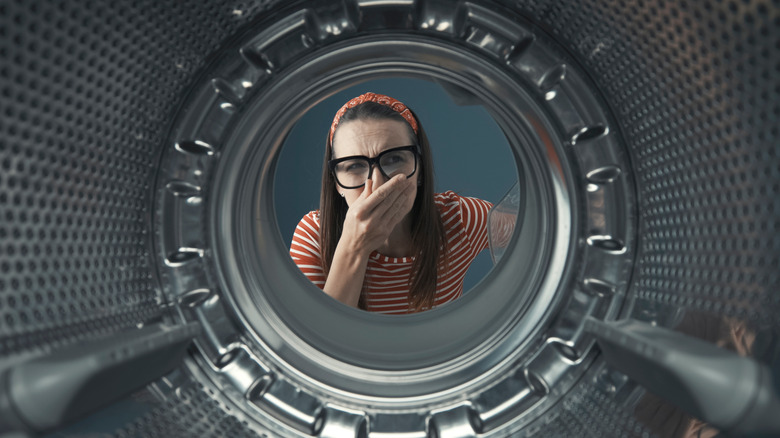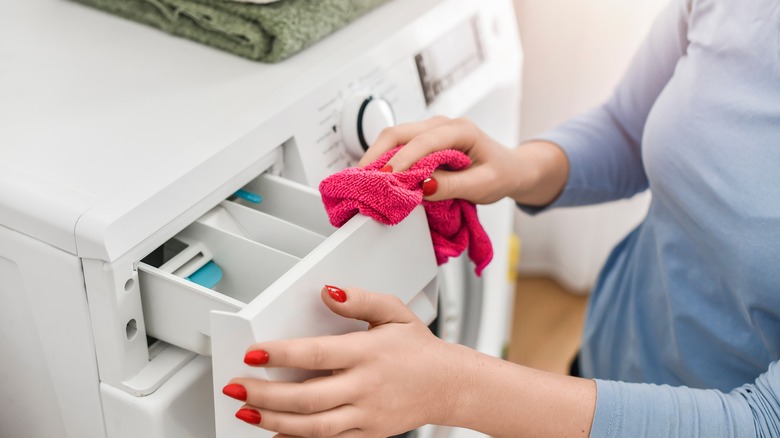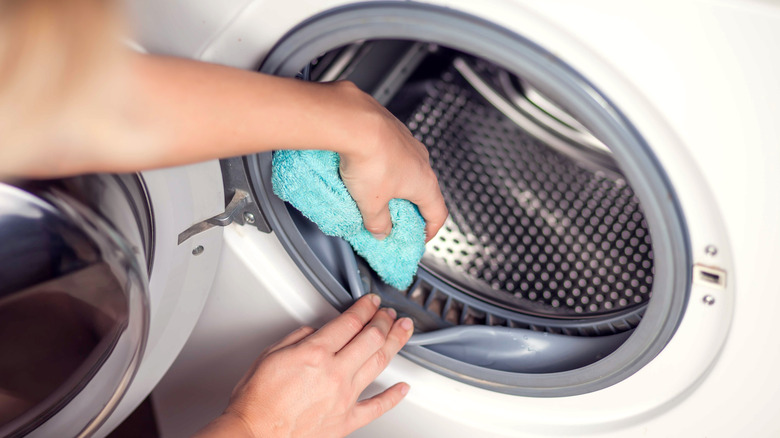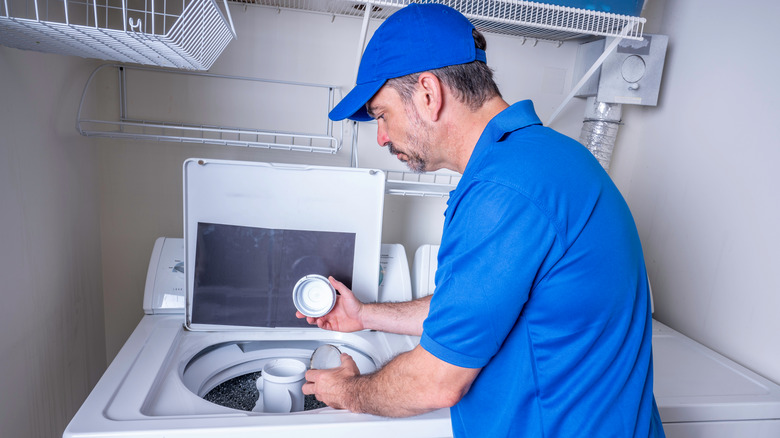We Bet You Aren't Cleaning A Key Part Of Your Washing Machine
Many people think that their washing machine gets cleaned every time it runs. But the truth is, whether you have a front-load or top-load washer, with every load of laundry, different parts of your machine actually get dirtier and dirtier in the form of residue buildup from detergent and the accumulation of other debris left behind. Even if you regularly clean the inside of your washing machine, you may still not be cleaning the worst of the grime and buildup. Much of the debris and residue accumulates in areas you can't see or easily access. As such, it's important to take apart certain components to be able to deep clean the washing machine properly –- something many people do not do, leading to a grime-ridden machine that can spread bacteria, lint, hair, and odors to your clothes with every wash.
Your washing machine's detergent dispenser is one of the most important features to clean, as it sees a lot of residue buildup from liquid detergent, which can create blockages and prevent your clothes from fully getting clean. Additionally, the rubber gasket on your washer's door and the area behind the lip needs to be regularly cleaned, as it can trap moisture, hair, and other debris, leading to mold, mildew, and odors. Many people also neglect the important step of cleaning their washer's filter, since it isn't always as easy to find and clean as other components of your machine.
Detergent dispenser
While it's easy to assume a part of the machine that holds detergent -– something designed to clean -– will clean the mechanism that dispenses it, your machine's detergent dispenser is actually a component that you need to take apart to clean most frequently. With every cycle, some detergent gets left behind in the dispenser, which can lead to a buildup of detergent, and an eventual blockage. A blockage in your dispenser can prevent your clothes and sheets from getting as clean as they should, and can leave them with a funky odor. Serious blockages in your detergent dispenser can even cause your washing machine to leak. This buildup can happen with both liquid and powder detergent, though using too much liquid detergent notoriously causes a lot of buildup if you aren't careful. Lint, pet fur, and more from your clothes can also get stuck to the sticky residue in the dispenser when you are loading your washing machine, which can worsen any blockages.
Fortunately, the detergent dispensers in most machines are removable, which makes them much easier to clean. After removing it, rinse it thoroughly under running water before using a soft cloth or bristled brush to scrub away any remaining residue or grime. Let it dry before re-attaching it to your machine. To keep your detergent dispenser properly clean and free of any residue buildup, take it out and repeat the process once every month or so, or after every five to 10 loads of laundry.
Rubber sealant
The rubber sealant on your machine's door and the unseen area behind it also need to be regularly cleaned in order to maintain the cleanliness of your washer and your clothes. Moisture can also easily get trapped behind the rubber seal, which can lead to mold and mildew. If you have a front-loading machine, pet hair, lint, and other debris easily stick to the rubber material, which can end up on your clothes. The debris can also slip behind the rubber gasket and get trapped, accumulating over time without regular cleaning.
Professional cleaner Tamara Nunes recommends filling a spray bottle with equal parts water and vinegar and spraying it all over the rubber. Be mindful of getting the hidden crevice behind the lip. "I then scrub with a clean cloth or soft-bristled brush, leave it to sit for 15 minutes or so, then wipe and dry with a clean towel," she told Homes & Gardens.
To prevent mildew and mold from forming in the future, remember to keep the rubber sealant dry by wiping it after every cycle with a dry cloth. Mold removal expert Michael Golubev told the outlet, "It's a good idea to clean your washing machine rubber gasket at least once a month or more frequently if you notice any mold or unpleasant odors."
Filter and agitator
Many people also tend to overlook the filter when cleaning their washing machine, possibly because it isn't always very easy to find. Your machine's filter can be found somewhere in the agitator if you have a top-loading machine. For a front-loading machine without an agitator, the filter is usually found somewhere near the top of the drum, on the machine's front exterior, or somewhere at the end of the drainage hose near the water pump. If you absolutely cannot find your machine's filter and have a newer model, it's possible yours doesn't have a filter at all. Many of the newer HE-labeled machines are designed to operate without a traditional filter.
Removing your machine's filter can be tricky, especially if it is in the agitator, so it's best to consult the owner's manual if you have it on hand to figure out how to do so. You can also look up the model of your washer online for further guidance. Once you have removed the filter –- and the agitator if your machine has one -– place it into a tub containing a mixture of ¼ cup of water, ¼ cup of baking soda, and two cups of vinegar. You can also use a mixture of hot water and mild dish soap. Let it soak before using a bristled brush to scrub off any remaining grime or debris. Rinse the soapy mixture off the filter and agitator before drying them and returning them to their place in the washer.



